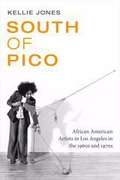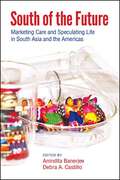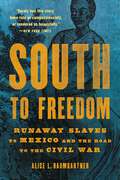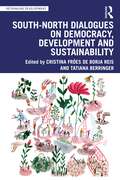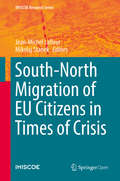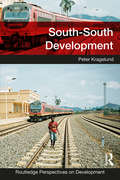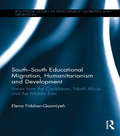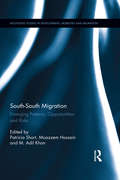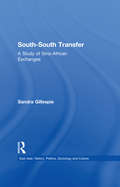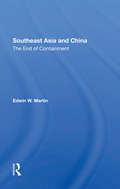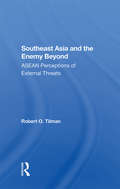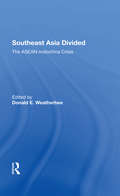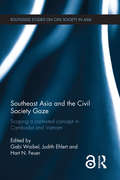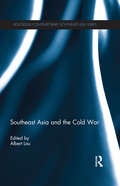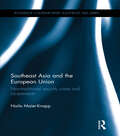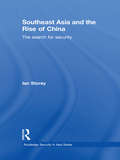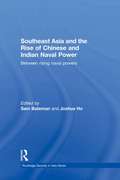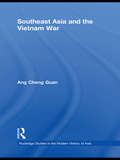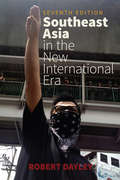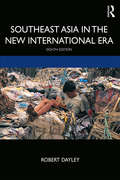- Table View
- List View
South of Pico: African American Artists in Los Angeles in the 1960s and 1970s
by Kellie JonesIn South of Pico Kellie Jones explores how the artists in Los Angeles's black communities during the 1960s and 1970s created a vibrant, productive, and engaged activist arts scene in the face of structural racism. Emphasizing the importance of African American migration, as well as L.A.'s housing and employment politics, Jones shows how the work of black Angeleno artists such as Betye Saar, Charles White, Noah Purifoy, and Senga Nengudi spoke to the dislocation of migration, L.A.'s urban renewal, and restrictions on black mobility. Jones characterizes their works as modern migration narratives that look to the past to consider real and imagined futures. She also attends to these artists' relationships with gallery and museum culture and the establishment of black-owned arts spaces. With South of Pico, Jones expands the understanding of the histories of black arts and creativity in Los Angeles and beyond.
South of the Future: Marketing Care and Speculating Life in South Asia and the Americas (SUNY series, Praxis: Theory in Action)
by Anindita Banerjee Debra A. CastilloSouth Asia and Latin America represent two epicenters of migrant care work and the globalized reproductive market. Yet scholars and the media continue to examine them in geographical and conceptual isolation. South of the Future closes both these gaps. It investigates nannying, elder care, domestic work, and other forms of migrant labor in the Americas together with the emerging "Wild West" of biotechnology and surrogacy in the Indian subcontinent. The volume is profoundly interdisciplinary and includes both prominent and emerging scholars from a wide variety of fields, including anthropology, law, literary and cultural studies, science and technology studies, and social policy. These contributors speak to the dynamic, continually changing facets of the nexus of care and value across these two key regions of the global south. By mobilizing specific locations and techno-economics and putting them into dialogue with one another, South of the Future rematerializes the gendered, racialized bodies that are far too often rendered invisible in structural analyses of the global south, or else are confined to particular geo- and biopolitical paradigms of emerging markets. Instead, these bodies occupy the center of a global, highly financialized economy of creating and sustaining life.
South to America: A Journey Below the Mason-Dixon to Understand the Soul of a Nation
by Imani PerryA Most Anticipated Book From: The New York Times • TIME • Oprah Daily • Vulture • Essence • Esquire • W Magazine • Atlanta Journal-Constitution • PopSugar • Book Riot • Chicago Review of Books • Electric Literature • Lit Hub. <p><p> An essential, surprising journey through the history, rituals, and landscapes of the American South—and a revelatory argument for why you must understand the South in order to understand America. <p><p> We all think we know the South. Even those who have never lived there can rattle off a list of signifiers: the Civil War, Gone with the Wind, the Ku Klux Klan, plantations, football, Jim Crow, slavery. But the idiosyncrasies, dispositions, and habits of the region are stranger and more complex than much of the country tends to acknowledge. In South to America, Imani Perry shows that the meaning of American is inextricably linked with the South, and that our understanding of its history and culture is the key to understanding the nation as a whole. <p><p> This is the story of a Black woman and native Alabaman returning to the region she has always called home and considering it with fresh eyes. Her journey is full of detours, deep dives, and surprising encounters with places and people. She renders Southerners from all walks of life with sensitivity and honesty, sharing her thoughts about a troubling history and the ritual humiliations and joys that characterize so much of Southern life. <p><p> Weaving together stories of immigrant communities, contemporary artists, exploitative opportunists, enslaved peoples, unsung heroes, her own ancestors, and her lived experiences, Imani Perry crafts a tapestry unlike any other. With uncommon insight and breathtaking clarity, South to America offers an assertion that if we want to build a more humane future for the United States, we must center our concern below the Mason-Dixon Line.
South to Freedom: Runaway Slaves to Mexico and the Road to the Civil War
by Alice L BaumgartnerA brilliant and surprising account of the coming of the American Civil War, showing the crucial role of slaves who escaped to Mexico.The Underground Railroad to the North promised salvation to many American slaves before the Civil War. But thousands of people in the south-central United States escaped slavery not by heading north but by crossing the southern border into Mexico, where slavery was abolished in 1837.In South to Freedom, historianAlice L. Baumgartner tells the story of why Mexico abolished slavery and how its increasingly radical antislavery policies fueled the sectional crisis in the United States. Southerners hoped that annexing Texas and invading Mexico in the 1840s would stop runaways and secure slavery's future. Instead, the seizure of Alta California and Nuevo México upset the delicate political balance between free and slave states. This is a revelatory and essential new perspective on antebellum America and the causes of the Civil War.
South-North Dialogues on Democracy, Development and Sustainability (Rethinking Development)
by Tatiana Berringer Cristina Fróes de Borja ReisThis book shows how bringing together experts from the Global South and the Global North can help us to understand and combat global economic, political, and social inequalities. For too long, the world’s problems have been viewed through the narrow conceptual lenses of the Global North. This book lays the groundwork for a new approach – a truly global approach to political economy. We are currently facing multiple and overlapping international crises. The current economic crisis, characterized by deepening inequalities, is closely intertwined with intensifying geopolitical rivalries and the environmental crisis. The dialogues in this book aim to move beyond the Eurocentric tradition and bring voices from the Global South to the forefront of the debate. Covering 11 key themes drawn from the United Nations’ Agenda 2030, the book conceptualizes democracy, development, and sustainability not only as strategies, but also as values that are integrated into the same – and continuously changing – analytical process. This book will be of great interest to students, researchers, and experts in international relations, global development, and international political economy, and to anyone looking for new perspectives on pernicious problems.
South-North Migration of EU Citizens in Times of Crisis
by Jean-Michel Lafleur Mikolaj StanekThis open access book looks at the migration of Southern European EU citizens (from Portugal, Spain, Italy, Greece) who move to Northern European Member States (Belgium, France, Germany, United Kingdom) in response to the global economic crisis. Its objective is twofold. First, it identifies the scale and nature of this new Southern European emigration and examines these migrants' socio-economic integration in Northern European destination countries. This is achieved through an analysis of the most recent data on flows and profiles of this new labour force using sending-country and receiving-country databases. Second, it looks at the politics and policies of immigration, both from the perspective of the sending- and receiving-countries. Analysing the policies and debates about these new flows in the home and host countries' this book shows how contentious the issue of intra-EU mobility has recently become in the context of the crisis when the right for EU citizens to move within the EU had previously not been questioned for decades. Overall, the strength of this edited volume is that it compiles in a systematic way quantitative and qualitative analysis of these renewed Southern European migration flows and draws the lessons from this changing climate on EU migration.
South-South Cooperation Beyond the Myths: Rising Donors, New Aid Practices? (International Political Economy Series)
by Isaline Bergamaschi, Phoebe Moore and Arlene B. TicknerThis book, which brings together scholars from the developed and developing world, explores one of the most salient features of contemporary international relations: South-South cooperation. It builds on existing empirical evidence and offers a comparative analytical framework to critically analyse the aid policies and programmes of ten rising donors from the global South. Amongst these are several BRICS (Brazil, India, China and South Africa) but also a number of less studied countries, including Cuba, Venezuela, the United Arab Emirates, Colombia, Turkey, and Korea. The chapters trace the ideas, identities and actors that shape contemporary South-South cooperation, and also explore potential differences and points of convergence with traditional North-South aid. This thought-provoking edited collection will appeal to students and scholars of international relations, international political economy, development, economics, area studies and business.
South-South Development (Routledge Perspectives on Development)
by Peter KragelundSouth-South Development examines the historical background for the current situation: why it suddenly took off again approximately a decade ago; the various vectors of engagement and how they are interrelated; the actors involved; how the revitalisation of South-South development has affected development cooperation ‘as it was’; and finally, how it affects the rest of the Global South. Based on primary research on how Southern actors – via investments, aid, and trade – are changing the face of development both in the Global North and the Global South, this book contextualises the current debates, provides a systematic overview, and brings together the key themes in South-South development. It explains how countries like China, India, and Brazil are influencing domestic politics in other countries of the Global South, how they invest, and how their aid alters power structures between ‘new’ and ‘old’ donors locally. It also explains migration patterns, how they use soft power tools, and how the global governance system is changing as a result of this. This comprehensive and student-focused book includes well developed pedagogy such as text boxes, chapter summaries, key questions, bibliography, weblinks, and annotated further reading. This book offers a unique combination of in-depth insights and secondary data on South-South development, presenting a ‘state-of-the-art’ account of South-South development aimed at students as well as practitioners in disciplines as diverse as International Development Studies, International Relations, Geography, Anthropology, Global Studies, and International Political Economy.
South-South Educational Migration, Humanitarianism and Development: Views from the Caribbean, North Africa and the Middle East (Routledge Studies in Development, Mobilities and Migration)
by Elena Fiddian-QasmiyehThis ground-breaking book is one of the first to analyse the important phenomenon of South-South educational migration for refugees. It focuses particularly on South-South scholarship programmes in Cuba and Libya, which have granted free education to children, adolescents and young adults from two of the world’s most protracted refugee situations: Sahrawis and Palestinians. Through in-depth multi-sited fieldwork conducted with and about Sahrawi and Palestinian refugee students in Cuba and Libya, and following their return to the desert-based Sahrawi refugee camps in Algeria and the urban Palestinian refugee camps in Lebanon, this highly pertinent study brings refugees’ views and voices to the forefront and sheds a unique light on their understandings of self-sufficiency, humanitarianism and hospitality. It critically assesses the impact of diverse policies designed to maximise self-sufficiency and to reduce both brain drain and ongoing dependency upon Northern aid providers, exploring the extent to which South-South scholarship systems have challenged the power imbalances that typically characterise North to South development models. Finally, this very timely study discusses the impact of the Arab Spring on Libya’s support mechanisms for Sahrawi and Palestinian refugees, and considers the changing nature of Cuba’s educational model in light of major ongoing political, ideological and economic shifts in the island state, asking whether there is a future for such alternative programmes and initiatives. This book will be a valuable resource for students, researchers and practitioners in the areas of migration studies, refugee studies, comparative education, development and humanitarian studies, international relations, and regional studies (Latin America, Middle East, and North Africa).
South-South Migration: Emerging Patterns, Opportunities and Risks (Routledge Studies in Development, Mobilities and Migration)
by Moazzem Hossain Patricia Short M. Adil KhanSouth-South migration contributes significantly to the development of the emerging economies, the migration of receiving countries and, at the same time, generates a major share of remittance income flowing into the sending countries. By capturing field experience and observations from a number of research studies, this book provides a robust catalogue of data, practical experience and analysis focused on the significant issues, risks and challenges that are associated with this evolving phenomenon in international migration. The book also critically explores new theoretical perspectives by highlighting new policy directions for both sending and receiving countries relevant to making South-South migration more efficient, attractive and mutually beneficial.
South-South Transfer: A Study of Sino-African Exchanges (East Asia)
by Sandra GillespieThis study directs attention towards a South-South dimension of knowledge transfer: specifically, China's educational exchange programs for Africa.
South-south Cooperation and Chinese Foreign Aid
by Meibo Huang Xiuli Xu Xiaojing MaoThis book is a collection of 15 case studies on China’s foreign aid and economic cooperation with developing countries. Each case introduces the general information of a China’s project, analyzes its features and impacts, and especially focuses on analysis of the characteristics of China’s foreign aid under South-South Cooperation framework, which shows the differences of foreign aid by emerging economies from that by traditional donors in aid ideology, principles, practices, and effects. This book is one of the research projects by China International Development Research Network (CIDRN), as part of its contribution to the activities under the Network of Southern Think-tanks (NeST).
Southeast Asia And China: The End Of Containment
by Edwin W. MartinSince the end of the war in Vietnam and the withdrawal of the American presence there, a marked realignment of power has taken place in Southeast Asia. The old rivalry between China and the United States has become a relationship of cautious rapprochement, while Sino-Soviet competition has been intensified by China's fear that the USSR will move to fill the power vacuum created by the U.S. departure. The United States no longer perceives a friendly Sino-Southeast Asian relationship to be as much of a danger to its security interests as it once did, but how that relationship develops remains of considerable importance to this country. In this book, Edwin Martin examines some of the principal factors in China's current relations with the Southeast Asian countries— China's domestic policies, Peking-oriented insurgency in Southeast Asian countries, the Overseas Chinese, trade considerations, the policies of third powers—and concludes that the newly emergent nationalism in Southeast Asia,coupled with Sino-Soviet rivalry, indeed diminishes the threat posed by a Communist Indochina and calls for a U.S. policy of encouraging stable relations in the area, both among the countries themselves and between them and the PRC. He asserts that a four-way balance of power— involving the United States, the USSR, the PRC, and Japan—will prevent a power vacuum in the area and will allow the Southeast Asian countries to develop their own strengths, both political and economic. It is thus to the advantage of the United States to encourage all steps toward regional cooperation; U.S. policy, Professor Martin concludes, should neither abandon Southeast Asia, nor attempt to dictate to it.
Southeast Asia And The Enemy Beyond: Asean Perceptions Of External Threats
by Robert O. TilmanThis book explores elite perceptions of the external threats facing the members of the Association of Southeast Asian Nations (ASEAN), drawing on Dr. Tilman's interviews with senior political, military, and intellectual leaders in Indonesia, Malaysia, the Philippines, Singapore, and Thailand. He supplements his interviews with an examination of their writings, speeches, and other public statements, which he examines in the context of the history, geography, culture, and governmental structures of each country. He addresses the fundamental questions of the extent to which these perceptions differ and why. His focus throughout is on subjective reality--the world as it is perceived by the leadership of the ASEAN nations.
Southeast Asia Divided: The Asean-indochina Crisis
by Donald E WeatherbeeThe central problem of international politics in Southeast Asia since December 1978 has been the Vietnamese armed presence in Kampuchea. The noncommunist nations of the Association of Southeast Asian Nations (ASEAN) have insisted that Vietnam withdraw from Kampuchea; the Vietnamese, perceiving a threat from the PRC and an ASEAN-sponsored Khmer resistance, maintain that the situation is irreversible. The contributors discuss the conflict from the point of view of all parties involved (ASEAN, Vietnam, the PRC, the USSR, and the U.S.) and assess various strategies for its resolution.
Southeast Asia and the Civil Society Gaze: Scoping a Contested Concept in Cambodia and Vietnam (Routledge Studies on Civil Society in Asia)
by Gabi Waibel; Judith Ehlert; Hart N. FeuerAs developing countries with recent histories of isolation and extreme poverty, followed by restoration and reform, both Cambodia and Vietnam have seen new opportunities and demands for non-state actors to engage in and manage the effects of rapid socio-economic transformation. This book examines how in both countries, civil society actors and the state manage their relationship to one another in an environment that is continuously shaped and (re)constructed by changing legislation, collaboration and negotiation, advocacy and protest, and social control. Further, it explores the countries’ divergent experiences whilst also uncovering the underlying basis and drivers of civil society activity that are shared by Cambodia and Vietnam. Crucially, this book engages with the contested nature of civil society and how it is socially constructed through research and development activities, by looking at contemporary discourses and manifestations of civil society in the two countries, including national and community-level organisations, associations, and networks that operate in a variety of sectors, such as gender, the environment and health. Drawing on extensive fieldwork conducted in Cambodia and Vietnam, this book will be of huge interest to students and scholars of Southeast Asian studies, Southeast Asian politics, development studies and civil society.
Southeast Asia and the Cold War (Routledge Contemporary Southeast Asia Series)
by Albert LauThe origins and the key defining moments of the Cold War in Southeast Asia have been widely debated. This book focuses on an area that has received less attention, the impact and legacy of the Cold War on the various countries in the region, as well as on the region itself. The book contributes to the historiography of the Cold War in Southeast Asia by examining not only how the conflict shaped the milieu in which national and regional change unfolded but also how the context influenced the course and tenor of the Cold War in the region. It goes on to look at the usefulness or limitations of using the Cold War as an interpretative framework for understanding change in Southeast Asia. Chapters discuss how the Cold War had a varied but notable impact on the countries in Southeast Asia, not only on the mainland countries belonging to what the British Foreign Office called the "upper arc", but also on those situated on its maritime "lower arc". The book is an important contribution to the fields of Asian Studies and International Relations.
Southeast Asia and the European Union: Non-traditional security crises and cooperation (Routledge Contemporary Southeast Asia Series)
by Naila Maier-KnappAmidst the Eurozone crisis, the European Union (EU) is stepping up its dialogue and engagement with and within Southeast Asia. The EU’s contemporary approach towards Asia emphasises the importance of open economies and common challenges of the 21st Century. So-called non-traditional security issues have been portrayed increasingly as an avenue to share experiences and enhance cooperation between the EU and Southeast Asia. This contemporary conceptual re-orientation demands a closer look at the EU as an actor in Southeast Asia. This book is the first contemporary monograph-length discussion of the EU as a politico-security actor in in the region post-Cold War. Drawing upon the historical and institutional context and a broad range of empirical case studies, it considers the non-traditional security crises of the late 1990s and early 2000s in Southeast Asia as triggers for enhanced regional and inter-regional cooperation. In doing so, the book construes new insights into our understanding of the EU as a global actor and its normative influence in regions far away from Europe. Providing a crisis-centric and sector-specific analysis which is much-needed, the book will be of interest to scholars of Southeast Asian Politics and European Politics, as well as policy-makers.
Southeast Asia and the Great Powers (Routledge Studies in the Modern History of Asia)
by Nicholas TarlingThe success of regionalism in Southeast Asia depends on the attitudes of the states within the region but also on the attitude of those outside it. This book is an erudite and stimulating study on the latter. Placing these states in a long term historical context Tarling brings out the way in which the rivalries of those powers within the region and outside it have affected the states within the region. He also shows how divisions within the region, and within states in the region, offered invitations and opportunities for intervention from outside, and so perhaps gave Southeast Asia an importance in international relations it would not otherwise have had. Regional leaders appear in recent decades to have recognised what may be construed as one of the lessons of history; if Southeast Asia can provide security for the Straits route, and stable conditions for trade and investment, it might enjoy both peace and a measure of prosperity. Southeast Asia and the Great Powers is an important read for students and scholars of the history and international relations of Southeast Asia.
Southeast Asia and the Rise of China: The Search for Security (Routledge Security in Asia Series)
by Ian StoreySince the early 1990s and the end of the Cold War, the implications of China's rising power have come to dominate the security agenda of the Asia-Pacific region. This book is the first to comprehensively chart the development of Southeast Asia’s relations with the People’s Republic of China (PRC) from 1949 to 2010, detailing each of the eleven countries’ ties to the PRC and showing how strategic concerns associated with China's regional posture have been a significant factor in shaping their foreign and defence policies. In addition to assessing bilateral ties, the book also examines the institutionalization of relations between the Association of Southeast Asian Nations (ASEAN) and China. The first part of the book covers the period 1949-2010: it examines Southeast Asian responses to the PRC in the context of the ideological and geopolitical rivalry of the Cold War; Southeast Asian countries’ policies towards the PRC in first decade of the post-Cold War era; and deepening ties between the ASEAN states and the PRC in the first decade of the twenty-first century. Part Two analyses the evolving relationships between the countries of mainland Southeast Asia - Vietnam, Thailand, Myanmar, Laos and Cambodia - and China. Part Three reviews ties between the states of maritime Southeast Asia - Indonesia, Malaysia, Singapore, the Philippines, Brunei and East Timor - and the PRC. Whilst the primary focus of the book is the security dimension of Southeast Asia-China relations, it also takes full account of political relations and the burgeoning economic ties between the two sides. This book is a timely contribution to the literature on the fast changing geopolitics of the Asia-Pacific region.
Southeast Asia and the Rise of Chinese and Indian Naval Power: Between Rising Naval Powers (Routledge Security in Asia Pacific Series)
by Sam Bateman Joshua HoThis book examines the emerging maritime security scene in Southeast Asia. It considers highly topical implications for the region of possible strategic competition between China and India - the rising naval powers of Asia - with a possible naval "arms race" emerging between these countries both with naval force development and operations. As part of its "Look East" policy, India has deployed naval units to the Pacific Ocean for port visits and exercises both with East Asian navies and the US Navy, but India is also concerned about the possibility of the Chinese Navy operating in the Indian Ocean. Even as the US-India defence relationship continues to deepen, the US and China are struggling to build a closer links. China’s and India’s strategic interests overlap in this region both in maritime strategic competition or conflict – which might be played out in the Bay of Bengal, the Malacca and Singapore Straits and the South China Sea. The sea lines of communication (SLOCs) through Southeast Asian waters constitute vital "choke points" between the Indian and Pacific Oceans carrying essential energy supplies for China and other Northeast Asian countries. Any strategic competition between China and India has implications for other major maritime players in the Pacific and Indian Oceans, especially Australia, the Republic of Korea and Japan, as well as the US. This book identifies possible cooperative and confidence-building measures that may contribute to enhanced relations between these two major powers and dampen down the risks associated with their strategic competition.
Southeast Asia and the Vietnam War (Routledge Studies in the Modern History of Asia)
by Cheng Guan AngThis book describes and explains Indonesia, Malaysia and Singapore’s attitudes and policies regarding the Vietnam War. While it is generally known that all three countries supported the US war effort in Vietnam, it reveals the motivations behind the decisions of the decision makers, the twists and turns and the nuances in the attitudes of Jakarta, Kuala Lumpur and Singapore following the development of the war from the 1950s through to its end in 1975. Although the principal focus is the three supposedly non-aligned countries - Indonesia, Malaysia and Singapore, the perspectives of Thailand and the Philippines - the two Southeast Asian countries which were formally allied with the United States - are discussed at the appropriate junctures. It makes an original contribution to the gradually growing literature on the international history of the Vietnam War and furthers our knowledge of the diplomatic history of Indonesia, Malaysia and Singapore in the early independent years, 1945/1949, 1957 and 1965 respectively, which coincided with early years of the Cold War in Southeast Asia.
Southeast Asia in Pre- and Post-COVID-19: Economy, Society, Mobility and Religion (COVID-19 in Asia)
by Noor Hasharina Hassan AKM Ahsan Ullah Shirley Chin LeeUllah, Chin, and Hassan provide a comprehensive examination of the transformative impact of the COVID-19 pandemic on Southeast Asia, examining its effects on the region’s economy, social dynamics, mobility patterns and religious practices.The book examines the profound changes and challenges that the region faced, offering insights into both the immediate responses and the long-term adjustments in these key aspects of Southeast Asian life. An in-depth analysis with a comprehensive and up-to-date perspective on the region’s postpandemic landscape offers informed insights into the diverse challenges and opportunities facing Southeast Asia in a rapidly changing world.This book is an essential reading for academics, researchers and policymakers seeking to gain a nuanced understanding of Southeast Asia’s response to the pandemic COVID-19.
Southeast Asia in the New International Era
by Robert DayleySoutheast Asia in the New International Era, seventh edition, provides readers with up-to-date coverage on a vibrant region home to more than 600 million people, vast cultural diversity, and dynamic globalized markets. Sensitive to historical legacies, and with special attention to developments since the end of the Cold War, this book highlights the events, players, and institutions that shape the region. Employing a country-by-country format, the analysis engages in context-specific treatment of the region's eleven countries: Thailand, Myanmar (Burma), Vietnam, Cambodia, Laos, the Philippines, Indonesia, Timor-Leste, Malaysia, Singapore, and Brunei. Each chapter focuses on political and economic developments, key institutions, state-society relations, and foreign affairs. In light of the December 2015 launch of the new ASEAN Community, this seventh edition includes a new chapter on ASEAN and the prospects of regional integration. An excellent resource for students, Southeast Asia in the New International Era makes sense of the region's coups, policy debates, protests, and alliances, leaving readers with a solid foundation for further study.
Southeast Asia in the New International Era
by Robert DayleyThis newly revised eighth edition of Southeast Asia in the New International Era provides readers with contemporary coverage of a vibrant region home to more than 650 million people, vast cultural diversity, and dynamic globalized markets. Sensitive to historical legacies and paying special attention to developments since the end of the Cold War, this book highlights the events, players, and institutions that shape the region. Employing a country-by-country format, the analysis engages in context-specific treatment of the region's eleven countries: Thailand, Myanmar (Burma), Vietnam, Cambodia, Laos, the Philippines, Indonesia, Timor-Leste, Malaysia, Singapore, and Brunei. Fully updated, the book’s revised content includes Rodrigo Duterte’s drug war in the Philippines, Malaysia’s historic 2018 election ending four decades of UMNO rule, Hun Sen’s latest power grab in Cambodia, and a consequential monarchical transition in post-coup Thailand. It also analyzes recent developments in the South China Sea dispute, the Rohingya tragedy in Myanmar, China’s expanding Belt and Road Initiative, as well as the effects of the Trump Administration’s tariffs and trade war. An excellent resource for students, this textbook makes sense of the region's coups, elections, policy debates, protests, and alliances, leaving readers with a solid foundation for further study.
